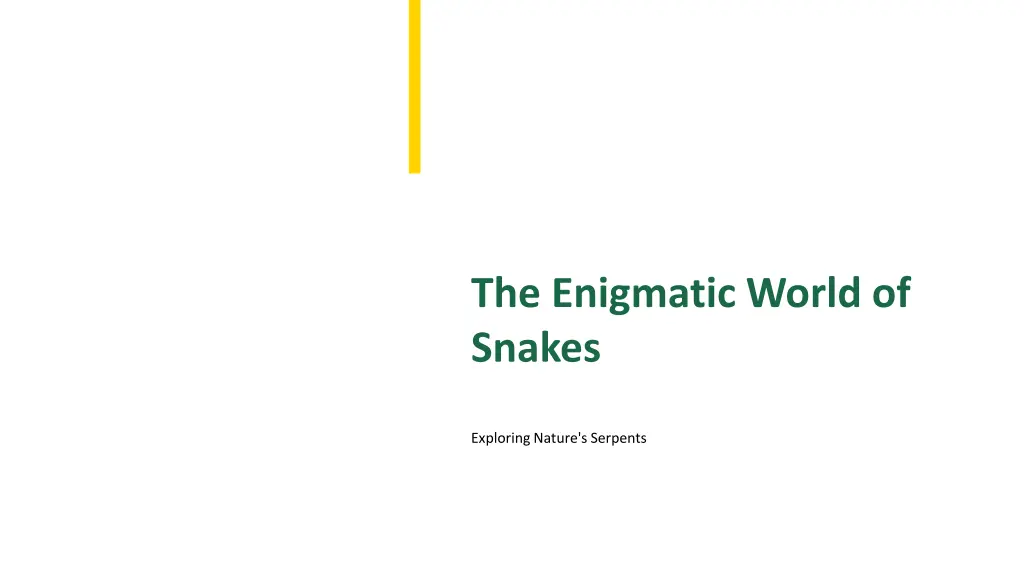
Discover the Enigmatic World of Snakes: Exploring Nature's Serpents
Dive into the mysterious realm of snakes with this comprehensive guide, covering their anatomy, diversity, feeding habits, venomous versus non-venomous distinctions, role in ecosystems, cultural significance, and conservation challenges. Explore the captivating world of these mystical reptiles through fascinating insights and captivating imagery.
Download Presentation

Please find below an Image/Link to download the presentation.
The content on the website is provided AS IS for your information and personal use only. It may not be sold, licensed, or shared on other websites without obtaining consent from the author. If you encounter any issues during the download, it is possible that the publisher has removed the file from their server.
You are allowed to download the files provided on this website for personal or commercial use, subject to the condition that they are used lawfully. All files are the property of their respective owners.
The content on the website is provided AS IS for your information and personal use only. It may not be sold, licensed, or shared on other websites without obtaining consent from the author.
E N D
Presentation Transcript
The Enigmatic World of Snakes Exploring Nature's Serpents Photo by Pexels
01 Introduction to Snakes Table of Contents 02 Anatomy of Snakes 03 Diversity of Species 04 Feeding Habits 05 Venomous vs Non-Venomous 06 Role in Ecosystems 07 Cultural Significance 08 Conservation Challenges 09 Conclusion 10 Thank You!
1 Introduction to Snakes Nature's Mystical Reptiles Snakes are fascinating reptiles that belong to the suborder Serpentes, showcasing remarkable adaptations for survival. With over 3,000 species worldwide, snakes inhabit diverse environments, from deserts to rainforests, exhibiting a wide range of sizes and colors. Their elongated, limbless bodies are perfectly designed for slithering, allowing them to navigate various terrains with ease. Understanding snakes can enrich our appreciation for biodiversity and the intricate web of life on Earth. Photo by Pexels
2 Anatomy of Snakes Unique Physical Traits Snakes possess a unique skeleton with over 200 vertebrae, enabling flexibility and movement in their elongated bodies. Their lack of limbs is compensated by powerful muscles that allow them to climb, swim, and burrowefficiently. Most snakes have specialized scales, aiding in traction and protection while they navigate their environments. Their forked tongues assist in smell detection, giving them an extraordinary sense of their surroundings. Photo by Pexels
3 Diversity of Species A World of Varieties Snakes vary greatly in size, from tiny blind snakes measuring just a few inches to giant pythons exceeding 20 feet. Different species exhibit diverse coloring patterns, aiding in camouflage, signaling, or warning predators and prey. Snakes can be categorized into venomous and non-venomous species, each with unique defense mechanisms and hunting strategies. This diversity highlights the evolutionary success of snakes in adapting to various ecological niches. Photo by Pexels
4 Feeding Habits Predatory Masters Snakes are carnivorous, employing various hunting techniques to capture prey, including ambush, constriction, and venom. Their ability to consume prey larger than their own body is facilitated by dislocating their jaws to swallow whole. Diet varies by species, with some preferring rodents, while others may feast on birds, amphibians, or even other snakes. This versatility underscores their significant role in maintaining ecological balance as predators. Photo by Pexels
5 Venomous vs Non- Venomous The Deadly Difference Venomous snakes possess specialized glands and fangs, allowing them to inject toxins into their prey efficiently. Common venomous species include rattlesnakes, cobras, and vipers, each with distinct venom compositions affecting prey differently. Non-venomous snakes often rely on alternative methods for hunting, showcasing nature's varied survival strategies. Understanding these differences is crucial for safety and conservation efforts. Photo by Pexels
6 Role in Ecosystems Nature's Balance Keepers Snakes play a critical role in food chains, controlling populations of rodents and other small animals. As both predators and prey, they contribute to ecological balance, supporting diverse animal communities. Healthy snake populations indicate ecosystem vitality, highlighting their importance in environmental health assessments. Conservation efforts must include protecting snake habitats to maintain biodiversity. Photo by Pexels
7 Cultural Significance Symbolism & Myths Snakes are prominent in various cultures, symbolizing power, transformation, and duality across myths and folklore. In many traditions, snakes evoke both fear and reverence, representing wisdom or danger depending on cultural context. Art, literature, and religious texts often include snakes, reflecting their complex relationshipwith humanity. This cultural significance emphasizes the need for a broader understanding of snakes beyond fear and misunderstanding. Photo by Pexels
8 Conservation Challenges Fighting for Survival Habitat destruction, climate change, and illegal wildlife trade threaten snake populations globally. Many species face extinction due to human activities, underscoring the need for conservation initiatives and awareness. Educating the public about snakes can help dispel myths and encourage coexistence with these reptiles. Conservation efforts are vital for preserving biodiversity, including all snake species. Photo by Pexels
9 Conclusion Embracing the Serpents Snakes, as complex and integral parts of ecosystems, deserve our respect and protection. By understanding their biology, behavior, and roles, we foster a deeper appreciationfor wildlife. As stewards of the environment, it is our responsibility to advocate for snake conservation efforts. Together, we can ensure that these ancient reptiles continue to thrive in their naturalhabitats. Photo by Pexels
10 Thank You! Appreciate Your Attention Thank you for exploring the captivating world of snakes with us today! Your interest and awareness contribute to conservation efforts for these vital creatures. Let's continue to learn and protect our natural world for future generations. Photo by Pexels
